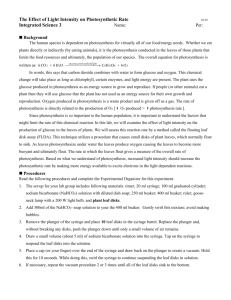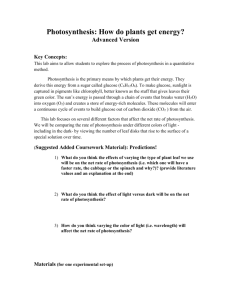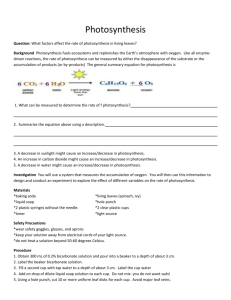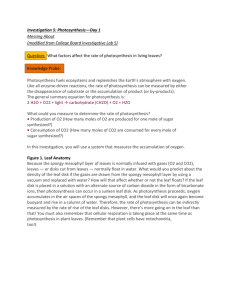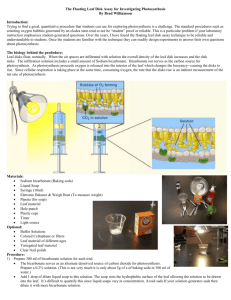Rate of Photosynthesis Lab
advertisement
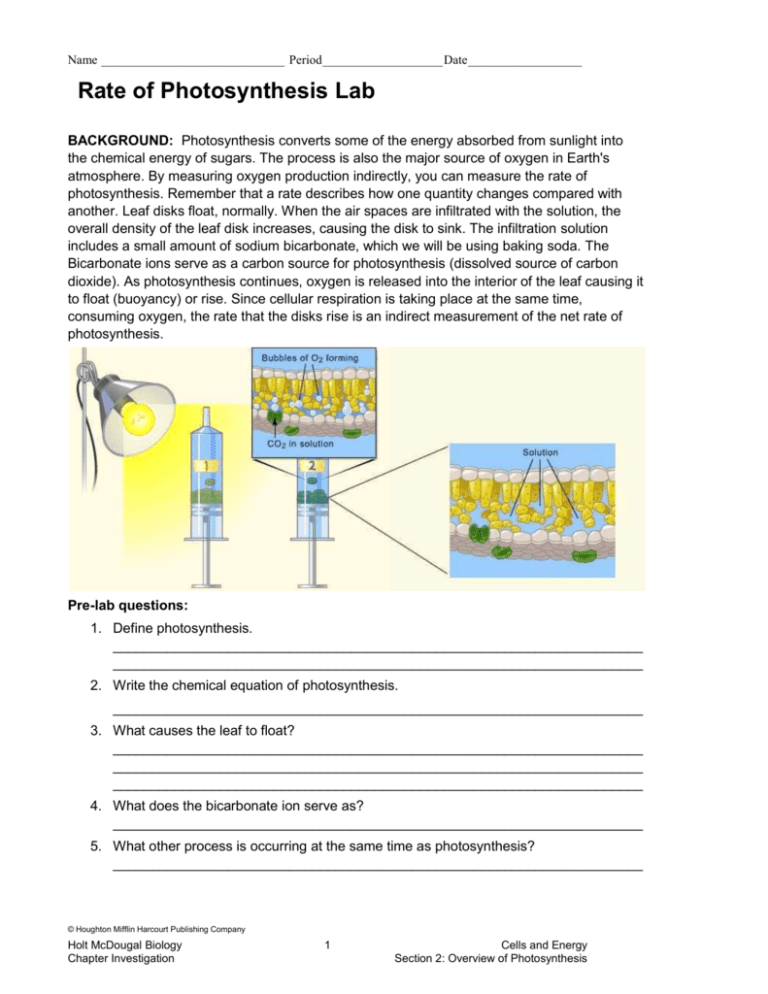
Name _____________________________ Period ___________________ Date __________________ Rate of Photosynthesis Lab BACKGROUND: Photosynthesis converts some of the energy absorbed from sunlight into the chemical energy of sugars. The process is also the major source of oxygen in Earth's atmosphere. By measuring oxygen production indirectly, you can measure the rate of photosynthesis. Remember that a rate describes how one quantity changes compared with another. Leaf disks float, normally. When the air spaces are infiltrated with the solution, the overall density of the leaf disk increases, causing the disk to sink. The infiltration solution includes a small amount of sodium bicarbonate, which we will be using baking soda. The Bicarbonate ions serve as a carbon source for photosynthesis (dissolved source of carbon dioxide). As photosynthesis continues, oxygen is released into the interior of the leaf causing it to float (buoyancy) or rise. Since cellular respiration is taking place at the same time, consuming oxygen, the rate that the disks rise is an indirect measurement of the net rate of photosynthesis. Pre-lab questions: 1. Define photosynthesis. _____________________________________________________________________ _____________________________________________________________________ 2. Write the chemical equation of photosynthesis. _____________________________________________________________________ 3. What causes the leaf to float? _____________________________________________________________________ _____________________________________________________________________ _____________________________________________________________________ 4. What does the bicarbonate ion serve as? _____________________________________________________________________ 5. What other process is occurring at the same time as photosynthesis? _____________________________________________________________________ © Houghton Mifflin Harcourt Publishing Company Holt McDougal Biology Chapter Investigation 1 Cells and Energy Section 2: Overview of Photosynthesis Name _____________________________ Period ___________________ Date __________________ PURPOSE: Design an experiment to test the effect of different light sources on the rate of photosynthesis PROBLEM: How does a light source affect the rate of photosynthesis? HYPOTHESIS: ___________________________________________________________________________ ___________________________________________________________________________ ___________________________________________________________________________ MATERIALS Young ivy leaves or fresh spinach Hole punch 100 mL beakers Plastic cups Sodium bicarbonate/detergent solution or baking soda Water Liquid soap Plastic 10 cc syringe Forceps Strong light sources Stopwatch OPTIONAL: Buffer Solutions Colored Cellophane or filters Leaf Material of different ages PROCEDURE 1. Prepare 300 ml. of bicarbonate solution for each trial (1/8 teaspoon of baking soda in 300 ml. of water). 2. Add 1 drop of diluted liquid soap to the bicarbonate solution. The soap wets the hydrophobic surface of the leaf allowing the solution to be drawn into the leaf. It’s difficult to quantify this because different soaps have different concentrations. Just try to avoid suds. If there are too many suds then dilute it with more bicarbonate solution. 3. Use the hole punch to make 10 disks from an ivy leaf. Make sure that you punch holes that are smooth and not too thick. 4. Fill one beaker halfway with the sodium bicarbonate/detergent solution. Fill a second beaker with water. 5. Remove the plunger from the syringe and place the ivy leaf disks into the syringe. Insert © Houghton Mifflin Harcourt Publishing Company Holt McDougal Biology Chapter Investigation 2 Cells and Energy Section 2: Overview of Photosynthesis Name _____________________________ Period ___________________ Date __________________ the plunger and draw 5 cc (5 mL) of the sodium bicarbonate/detergent solution into the syringe as shown below. Be careful when you do this so that you don’t crush the disks. 5. Hold the syringe so that the tip is pointing upwards. Push on the plunger to squirt out any air in the syringe. 6. Place your finger on the tip of the syringe, as shown below. Withdraw the plunger to form a vacuum, but be careful to not pull the plunger all the way out of the syringe. When the vacuum is formed, the gases in the air spaces in the leaf disks move into the syringe and the solution diffuses into the air spaces. 7. Take your finger off of the tip of the syringe. This causes the leaf disks to sink to the bottom of the syringe because they become more dense from the diffusion of solution into the air spaces. You may have to do this several times. If after three times and your disks do not sink, it may be because there is not enough soap in the solution. Add a few more drops. 8. Open the syringe by pulling the plunger almost all the way out. Place your finger over the tip of the syringe and turn it so the tip is pointing down. Carefully remove the plunger and pour the contents of the syringe into the beaker of water. Use the forceps to remove the leaf disks if they stick to the walls of the syringe. For a control infiltrate the leaf disks with a solution of only water with a drop of soap, no bicarbonate. © Houghton Mifflin Harcourt Publishing Company Holt McDougal Biology Chapter Investigation 3 Cells and Energy Section 2: Overview of Photosynthesis Name _____________________________ Period ___________________ Date __________________ 9. Place the beaker with the leaf disks under the light source and immediately start the stopwatch. At the end of each minute record the number of floating disks. As the leaf disks begin to photosynthesize, the production of oxygen replaces the solution in the air spaces and the disks become less dense and float to the top of the water. Data Collection: Minutes Disks Floating 1 2 Independent Variable= ___________________________ Dependent Variable= ___________________________ 3 4 5 6 7 8 9 10 11 12 13 14 15 16 17 18 19 20 © Houghton Mifflin Harcourt Publishing Company Holt McDougal Biology Chapter Investigation 4 Cells and Energy Section 2: Overview of Photosynthesis Name _____________________________ Period ___________________ Date __________________ ANALYZE AND CONCLUDE 1. Identify What are the independent and dependent variables in your experiment? Also, what were your constants and control? ________________________________________________________________________ ________________________________________________________________________ ________________________________________________________________________ 2. Calculate Determine the mean rate of photosynthesis in your experiment. To calculate the rate of photosynthesis, use the formula below: 5 (# disks floating) ____________ disks/sec total time (sec) 3. Analyze Make a line graph to represent your data. Explain your choice and construct the graph. Be sure to carefully label the axes of the graph. © Houghton Mifflin Harcourt Publishing Company Holt McDougal Biology Chapter Investigation 5 Cells and Energy Section 2: Overview of Photosynthesis Name _____________________________ Period ___________________ Date __________________ 4.Conclude Based on your data, what can you conclude about how your independent variable affects the rate of photosynthesis? ________________________________________________________________________ ________________________________________________________________________ ________________________________________________________________________ 5. Infer Why do you think sodium bicarbonate was used in this investigation? (Hint: Think about the equation for the overall process of photosynthesis.) ________________________________________________________________________ ________________________________________________________________________ ________________________________________________________________________ 6. Experimental Design Identify possible reasons for inconsistent results. ________________________________________________________________________ ________________________________________________________________________ ________________________________________________________________________ 6. Why did you record the time it took for the ivy discs to float? What is the significance of them floating? _______________________________________________________________________ _______________________________________________________________________ _______________________________________________________________________ 7. Why do you think light source affects the rate of photosynthesis? _______________________________________________________________________ _______________________________________________________________________ _______________________________________________________________________ _______________________________________________________________________ © Houghton Mifflin Harcourt Publishing Company Holt McDougal Biology Chapter Investigation 6 Cells and Energy Section 2: Overview of Photosynthesis Name _____________________________ Period ___________________ Date __________________ Extension: Remove the disks from the light and place the cups of floating disks in the dark (perhaps use a shoebox). Every minute remove the box, count how many are still floating, and then record the time on the data table. Make sure you start off on whatever minute you left off on prior to the darkness. For example if they all were floating on minute 15, then minute 16 would start off this portion of the experiment. Minute Disks Still Floating Make any notes or observations you see while this happens. © Houghton Mifflin Harcourt Publishing Company Holt McDougal Biology Chapter Investigation 7 Cells and Energy Section 2: Overview of Photosynthesis Name _____________________________ Period ___________________ Date __________________ Graph the results from both the light and dark. Question: 1. At what time did the disks begin to sink? Why did this happen? _____________________________________________________________________ _____________________________________________________________________ _____________________________________________________________________ _____________________________________________________________________ © Houghton Mifflin Harcourt Publishing Company Holt McDougal Biology Chapter Investigation 8 Cells and Energy Section 2: Overview of Photosynthesis
